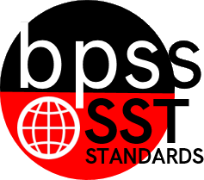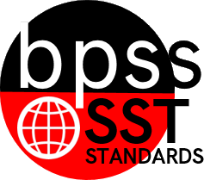1st Grade Social Studies (Archived)
 BPS District Social Studies Standards Book
BPS District Social Studies Standards Book
SST-01 "I can ... statements"
1st Grade Social Studies
2nd Grade Social Studies
4th Grade Social Studies
5th Grade Social Studies
7th Grade Social Studies
8th Grade Social Studies
| Prioritized Benchmarks |
SST-01.1.01
Student Learning Targets:Knowledge Targets
Proficiency Rubric
ResourcesWebsites Helping Your Child With Social Studies
Vocabulary
| ||||||||||||||||||||||||||||||||||||||||
SST-01.2
Narrative for the Important Historical EventsAt the first grade level, students develop thinking and decision-making skills through active participation as members of their school and neighborhood. They learn to identify events and changes taking place in the school and local community and classify events as taking place “today,” “yesterday,” and “long ago.” In the history standards, students identify continuity and change in the different environments around them, including school and neighborhood communities, and identify individuals, events and symbols that are important to our country.Identify people and events observed in national celebrations and holidays. Example: Celebrations and holidays, such as Thanksgiving; Reverend Martin Luther King, Jr. Day; Presidents’ Day; Independence Day; Arbor Day; and Veterans’ Day Calculation Method for StandardsStandards are larger groups of related benchmarks. The Standard Grade is a calculation of all the related benchmarks. Click on the benchmark name below each Standard to access the learning targets and proficiency rubrics for each standard's related benchmarks. | |
SST-01.2.03
Student Learning Targets:Knowledge Targets
Proficiency Rubric
ResourcesWebsites Helping Your Child With Social Studies Vocabulary
| ||||||||||||||||||||||||||||||||||||||||
SST-01.3
Narrative for the Economic ConceptsAt the first grade level, students develop thinking and decision-making skills through active participation as members of their school and neighborhood. First grade students have the opportunities to discuss ways in which people are alike and different and how people around the world work and use resources to meet their needs. In the Economics standards students explain how people in the school and community use goods and services and make choices as both producers and consumers. Calculation Method for StandardsStandards are larger groups of related benchmarks. The Standard Grade is a calculation of all the related benchmarks. Click on the benchmark name below each Standard to access the learning targets and proficiency rubrics for each standard's related benchmarks. | |
SST-01.3.01
Student Learning Targets:Knowledge Targets
Reasoning Targets
Proficiency Rubric
ResourcesWebsites Helping Your Child With Social Studies
Vocabulary
| ||||||||||||||||||||||||||||||||||||||||
SST-01.4
Narrative for the Government and CitizenshipAt the first grade level, students develop thinking and decision-making skills through active participation as members of their school and neighborhood. First grade students have the opportunities to discuss ways in which people are alike and different and how people around the world work and use resources to meet their needs. Students in grade one learn to explain why rules are needed in groups and learn how to apply rules to different group situations. They are given opportunities to practice citizenship skills through participation in a variety of group activities. Calculation Method for StandardsStandards are larger groups of related benchmarks. The Standard Grade is a calculation of all the related benchmarks. Click on the benchmark name below each Standard to access the learning targets and proficiency rubrics for each standard's related benchmarks. | |
SST-01.4.01
Student Learning Targets:Skills (Performance) Targets
Proficiency Rubric
ResourcesWebsites Helping Your Child With Social Studies Vocabulary
| ||||||||||||||||||||||||||||||||||||||||
SST-01.4.02
Student Learning Targets:Reasoning Targets
Proficiency Scale
ResourcesWebsites Helping Your Child With Social Studies
Vocabulary
| ||||||||||||||||||||||||||||||||||||||||
SST-01.5
Narrative for the Concepts of GeographyAt the first grade level, students develop thinking and decision-making skills through active participation as members of their school and neighborhood. They explore geographic relationships in their immediate environment, make models and maps to show locations of familiar surroundings, and recognize maps and globes as representations of the Earth. With the geography standards, students identify the basic elements of maps and globes and explain basic facts concerning the relationship of the sun to daily and seasonal weather. They identify selected geographic characteristics of their home, school and neighborhood. Calculation Method for StandardsStandards are larger groups of related benchmarks. The Standard Grade is a calculation of all the related benchmarks. Click on the benchmark name below each Standard to access the learning targets and proficiency rubrics for each standard's related benchmarks. | |


 Standard 1:
Standard 1: